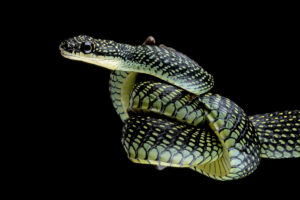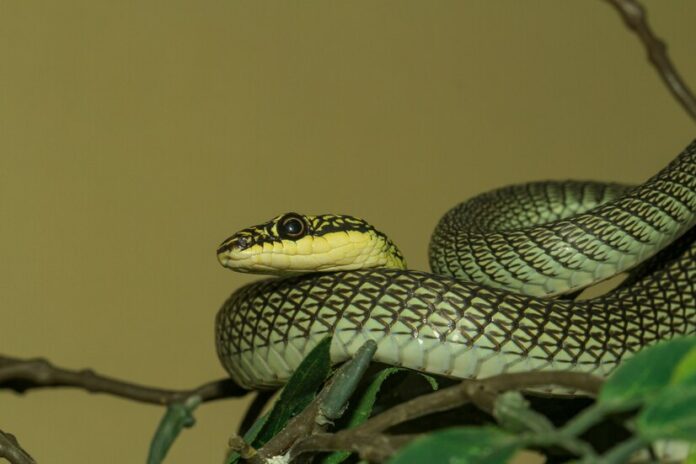Southeast Asia. They are found in the tropical forests of Thailand, Malaysia, and
Indonesia.
The fascination with flying snakes comes from their ability to seemingly defy the laws of
physics and move gracefully and effortlessly through the air. It is also interesting to
observe how they use their body shape and movement to glide and how they can
navigate and control their flight.
They are able to do this by flattening their body and undulating in a wave–like motion,
creating lift and allowing them to glide from tree to tree or over obstacles.
They have a unique and striking appearance, with bright colors and patterns on their
scales. Their ability to glide has also adapted them to live in unique environments, such
as forests and rainforests, where they can stay for safety or hunt prey.
The sight of a flying snake gliding through the air is a truly fantastic spectacle, and their
unique abilities have long captivated the curiosity of scientists and the general public
alike.

Facts about the Flying Snakes
1. Flying snakes, also known as Chrysopelea species, are a group of snakes found in
Southeast Asia. Despite their impressive ability to glide, flying snakes are non–
venomous and pose no threat to humans.
2. They are not capable of true flight but rather glide through the air using their
flattened bodies and undulating movements.
3. Flying snakes can glide for distances of up to 100 meters and reach heights of up
to 50 meters.
4. They can control their direction and speed while gliding by adjusting their body
position and movements.
5. They are primarily arboreal, meaning they live in trees and are excellent
climbers.
6. They use their ability to glide to escape predators and to forage for food in trees.
7. Flying snakes are generally less than a meter (3.3 feet) in length and have a
bright green color with black and white bands.
8. They are brightly colored, with patterns of yellow, green, and black on their
scales.
9. Their diet consists primarily of small rodents, lizards, and birds.
10. Various astonishing facts are being discovered by scientists studying their air
gliding mechanisms, which may have further commercial applications. In 2013, a
team of researchers from Virginia Tech University found that flying snakes use
their scales to create vortexes that allow them to glide more efficiently.
Names of Flying Snakes
2. Chrysopelea paradisi (paradise flying snake)
3. Chrysopelea pelias (pelias flying snake)
4. Chrysopelea rhodopleura (rhodopleura flying snake)
5. Chrysopelea taprobanica (taprobanica flying snake)
6. Chrysopelea volitans (volitans flying snake)
7. Ahaetulla nasuta (green vine snake)
8. Dendrelaphis punctulata (red–necked keelback)
9. Dryophiops philippina (Philippine flying snake)
10. Ptyas mucosa (common tree snake)
The destruction of these forests has significantly reduced their habitat and made it difficult
for them to find food and shelter. They are often hunted for their skin and meat, further
reducing their numbers. Climate change is also impacting the availability of food and water
sources for the snakes. Conservation efforts such as reforestation and protection of their
habitats are necessary to ensure the survival of the flying snake population. These snakes are protected under the Convention on International Trade in Endangered Species of Wild Fauna and Flora (CITES).
